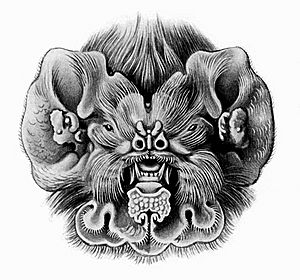Antillean ghost-faced bat facts for kids
Quick facts for kids Antillean ghost-faced bat |
|
|---|---|
 |
|
| Conservation status | |
| Scientific classification | |
| Genus: |
Mormoops
|
| Species: |
blainvillei
|
The Antillean ghost-faced bat (Mormoops blainvillei) is a unique type of bat. It belongs to a family called Mormoopidae. You can find this bat living on several Caribbean islands. These include Cuba, the Dominican Republic, Haiti, Jamaica, and Puerto Rico.
Contents
About the Antillean Ghost-Faced Bat
What Does It Look Like?
These bats can be different shades of brown. Some are a light cinnamon color, while others are more reddish. Their back (called the dorsal side) is usually darker. Their belly (called the ventral side) is lighter. Scientists have not seen these bats change their fur color. Also, their color does not seem to change based on where they live.
Like other bats in the Mormoops group, the Antillean ghost-faced bat has a very special face. It has many folds and leaf-like parts. Its nose is on a soft, fleshy pad. It also has stiff hairs sticking out from both its upper and lower lips.
Where Did It Come From?
We don't have many old bones or traces (fossils) of this bat. But the few fossils found suggest it once lived in more places. It might have lived across all the Caribbean islands and even the Bahamas.
Life and Habits
Where Do They Live?
The Antillean ghost-faced bat mostly lives in deep, protected caves. They also like abandoned mine shafts. They prefer caves that don't have too many entrances. In these places, they often share their homes with other types of bats.
What Do They Eat?
Scientists have looked at what's inside the stomachs of these bats. They found that these bats eat only insects. They catch their food in the air. They use a special pouch formed by their large, leaf-like tail membrane. Their favorite food is moths.
How They Behave
When Are They Active?
The Antillean ghost-faced bat is a nocturnal animal. This means it is only active at night. They usually start flying about 22 to 55 minutes after the sun sets. They wait until later because that's when their favorite prey, moths (which are a type of Lepidoptera), are most active.
How Do They Fly and Find Food?
This bat flies faster and higher than other bats in its group. When it flies, you might hear a distinct humming sound. Like many other bats, they use special sounds to find things. This is called echolocation or biosonar.
When the bat is looking for a moth, it makes short sounds. These sounds last about 1.8 milliseconds. As it gets closer to its target, the sounds become even shorter. When it's very close to catching the moth, it makes many very short calls.
How Do They Have Babies?
The mating season for these bats starts in January and February. Female bats become pregnant from March to May. The first baby bats are usually born in June. The babies stop drinking milk from their mothers around August or September. From October to December, the female bats are not ready to mate again.
Most female bats have one baby each year. It's very rare for them to have twins. Only two cases of twins have ever been reported.
How Their Bodies Work
Body Shape and Flying
The Antillean ghost-faced bat has a body shape similar to another bat called M. megalophylla. Bats in the Mormoops group have special body features. These help them be lighter and fly better. For example, some of their muscles are smaller or even missing. This is compared to bats in the Phyllostomidae family. These changes help them fly for longer periods. Their body shape is also perfect for catching and eating insects.
Keeping Warm
These bats can keep their body temperature stable. They do this between 31 and 34 degrees Celsius (88 to 93 degrees Fahrenheit). They can keep this temperature even when the air around them changes a lot. This works for temperatures from 15 to 41 degrees Celsius (59 to 106 degrees Fahrenheit).
However, if the air temperature drops below 28 degrees Celsius (82 degrees Fahrenheit), it's harder for them to stay warm. Some bats have been seen to drop their body temperature below 25 degrees Celsius (77 degrees Fahrenheit). When it gets cold, these bats make their bodies work harder. This helps them produce more heat and stay warm.
Images for kids
See also
 In Spanish: Murciélago verrugoso de Jamaica para niños
In Spanish: Murciélago verrugoso de Jamaica para niños



